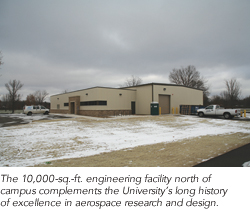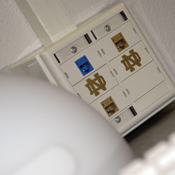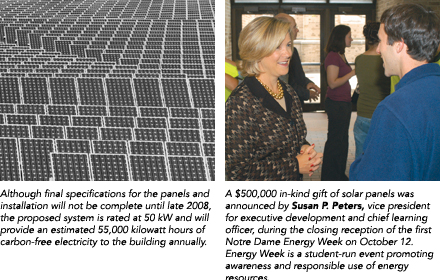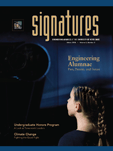an update on Engineering Structures
CONSTRUCTION NEARLY COMPLETE ON WHITE FIELD
 Construction began earlier this
year on the 10,000-sq.-ft., $1.9 million facility that will be part of the
Center for Flow Physics and Control (FlowPAC). Located north of campus in
an area previously used for football weekend parking, the building will house
a new wind tunnel, and compressor and turbine facilities. Construction began earlier this
year on the 10,000-sq.-ft., $1.9 million facility that will be part of the
Center for Flow Physics and Control (FlowPAC). Located north of campus in
an area previously used for football weekend parking, the building will house
a new wind tunnel, and compressor and turbine facilities.
The $3 million
wind tunnel, which was designed by Thomas C. Corke, the Clark Equipment Professor
of Aerospace and Mechanical Engineering and Director of FlowPAC, and six
undergraduates in the Department of Aerospace and Mechanical Engineering,
features an 8-ft. diameter fan, weighs 8.5 tons, and requires a 1,750-horsepower
motor to operate it. Winds in the 3-sq.-ft. experimental cross-section of
the tunnel can reach up to Mach 0.6, all of which make this a unique facility
for any university. The tunnel, which is funded by the Air Force Office of
Scientific Research (AFOSR), allows Notre Dame researchers to run their experiments
at higher speeds, much closer to actual flight conditions. Some of the initial
experiments that will be conducted in the new tunnel will focus on the next
generation of ultra-efficient airplanes and pilotless aircraft.
In addition
to the new wind tunnel, an existing $.5 million compressor, formerly housed
in the Hessert Laboratory for Aerospace Research, and a new $1.8 million
turbine will be housed in the new facility. The compressor and turbine were
also funded through the AFOSR. Construction is expected to be complete in
January 2008.
CAMPUS-WIDE NETWORK UPGRADE HITS ENGINEERING Several years
ago, the Office of Information Technologies (OIT) began recabling the University
as part of a campus-wide network upgrade. The College of Engineering had
been working with OIT’s Integrated Communications Services (ICS) to
custom build the engineering portion of the network to not only meet current
needs, but also to take the college well into the future. The same type of
networking now being installed in Cushing  Hall, dedicated in 1932, and Fitzpatrick
Hall, dedicated in 1979, will be installed in Stinson-Remick Hall, the new
engineering facility currently under construction on Notre Dame Avenue. When
the networking upgrade is complete in early 2008, all of the rooms in Cushing
and Fitzpatrick will be re-wired with three Category 6 (Cat 6) copper cables
and three pairs of 9-micron single-mode fiber. The Cat 6 cables will provide
higher bandwidth connections to the campus network infrastructure for all
engineering users. The single-mode fiber will allow researchers to build
custom interconnections between the research facilities within the college.
These connections may be used in many ways: to transport sensitive data between
research centers without exposing it to the public campus infrastructure,
to quickly transport large volumes of data between research data-collection
instruments, and compute/storage locations, to build high-speed connections
between research centers on campus where such connections are currently not
available, and to facilitate research that would not be possible without
the capabilities provided by a fiber infrastructure. The fiber essentially
provides unlimited bandwidth and will be able to carry hundreds of gigabits
of data per second. Hall, dedicated in 1932, and Fitzpatrick
Hall, dedicated in 1979, will be installed in Stinson-Remick Hall, the new
engineering facility currently under construction on Notre Dame Avenue. When
the networking upgrade is complete in early 2008, all of the rooms in Cushing
and Fitzpatrick will be re-wired with three Category 6 (Cat 6) copper cables
and three pairs of 9-micron single-mode fiber. The Cat 6 cables will provide
higher bandwidth connections to the campus network infrastructure for all
engineering users. The single-mode fiber will allow researchers to build
custom interconnections between the research facilities within the college.
These connections may be used in many ways: to transport sensitive data between
research centers without exposing it to the public campus infrastructure,
to quickly transport large volumes of data between research data-collection
instruments, and compute/storage locations, to build high-speed connections
between research centers on campus where such connections are currently not
available, and to facilitate research that would not be possible without
the capabilities provided by a fiber infrastructure. The fiber essentially
provides unlimited bandwidth and will be able to carry hundreds of gigabits
of data per second.
ICS will also be bolstering the engineering wireless
infrastructure. The bottom line is that the upgrade supports the high-performance
computing research and academic networking needs of the college.
SOLAR PANELS TO HELP POWER NEW BUILDING AND STUDENT DEVELOPMENT
General Electric (GE) has donated a photovoltaic solar array that will be
incorporated into the new Stinson-Remick Hall of Engineering. “With more than 400 Notre Dame
alumni, GE is proud to make a donation that will promote awareness of clean
technology solutions and support the University’s goal to expand and
enhance the learning opportunities for our future technical leaders,” said
Lorraine Bolsinger, vice president for ecomagination at GE. “This contribution
provides the students an immediate oppor-tunity for exploration and practical
experience, including future engineering curriculum expansion, as they solve
the energy issues of the next generation.”
 The
array — the first
application of renewable energy on campus — will be monitored by a
system in the McCourtney Learning Center, where undergraduates will be able
to track the energy being generated. This also gives faculty the opportunity
to build course curricula around the system. The
array — the first
application of renewable energy on campus — will be monitored by a
system in the McCourtney Learning Center, where undergraduates will be able
to track the energy being generated. This also gives faculty the opportunity
to build course curricula around the system.
|


 Construction began earlier this
year on the 10,000-sq.-ft., $1.9 million facility that will be part of the
Center for Flow Physics and Control (FlowPAC). Located north of campus in
an area previously used for football weekend parking, the building will house
a new wind tunnel, and compressor and turbine facilities.
Construction began earlier this
year on the 10,000-sq.-ft., $1.9 million facility that will be part of the
Center for Flow Physics and Control (FlowPAC). Located north of campus in
an area previously used for football weekend parking, the building will house
a new wind tunnel, and compressor and turbine facilities.  Hall, dedicated in 1932, and Fitzpatrick
Hall, dedicated in 1979, will be installed in Stinson-Remick Hall, the new
engineering facility currently under construction on Notre Dame Avenue. When
the networking upgrade is complete in early 2008, all of the rooms in Cushing
and Fitzpatrick will be re-wired with three Category 6 (Cat 6) copper cables
and three pairs of 9-micron single-mode fiber. The Cat 6 cables will provide
higher bandwidth connections to the campus network infrastructure for all
engineering users. The single-mode fiber will allow researchers to build
custom interconnections between the research facilities within the college.
These connections may be used in many ways: to transport sensitive data between
research centers without exposing it to the public campus infrastructure,
to quickly transport large volumes of data between research data-collection
instruments, and compute/storage locations, to build high-speed connections
between research centers on campus where such connections are currently not
available, and to facilitate research that would not be possible without
the capabilities provided by a fiber infrastructure. The fiber essentially
provides unlimited bandwidth and will be able to carry hundreds of gigabits
of data per second.
Hall, dedicated in 1932, and Fitzpatrick
Hall, dedicated in 1979, will be installed in Stinson-Remick Hall, the new
engineering facility currently under construction on Notre Dame Avenue. When
the networking upgrade is complete in early 2008, all of the rooms in Cushing
and Fitzpatrick will be re-wired with three Category 6 (Cat 6) copper cables
and three pairs of 9-micron single-mode fiber. The Cat 6 cables will provide
higher bandwidth connections to the campus network infrastructure for all
engineering users. The single-mode fiber will allow researchers to build
custom interconnections between the research facilities within the college.
These connections may be used in many ways: to transport sensitive data between
research centers without exposing it to the public campus infrastructure,
to quickly transport large volumes of data between research data-collection
instruments, and compute/storage locations, to build high-speed connections
between research centers on campus where such connections are currently not
available, and to facilitate research that would not be possible without
the capabilities provided by a fiber infrastructure. The fiber essentially
provides unlimited bandwidth and will be able to carry hundreds of gigabits
of data per second.  The
array — the first
application of renewable energy on campus — will be monitored by a
system in the McCourtney Learning Center, where undergraduates will be able
to track the energy being generated. This also gives faculty the opportunity
to build course curricula around the system.
The
array — the first
application of renewable energy on campus — will be monitored by a
system in the McCourtney Learning Center, where undergraduates will be able
to track the energy being generated. This also gives faculty the opportunity
to build course curricula around the system.